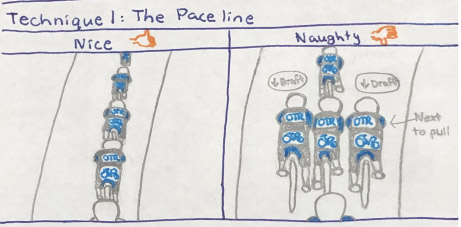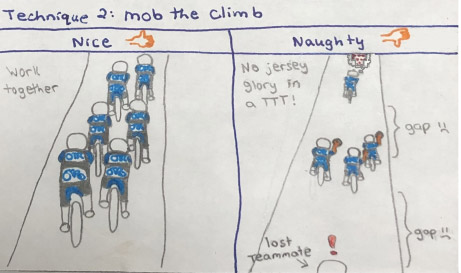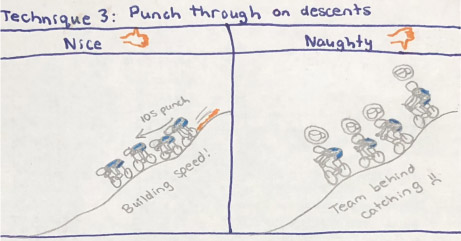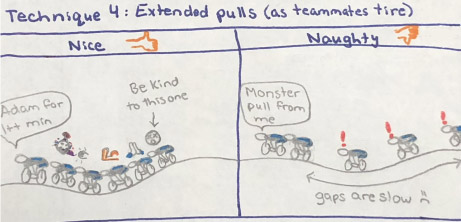A few weeks back, Zwifter Jen Moroz shared some fun hand-drawn team time-trialing technique illustrations on the FemmeCycle Collab Discord server. I found them to be quite insightful, and I love that she took the time to draw them out. So I asked if I could share them with the Zwift community this week as we prepare for next week’s ZRL TTT on Greater London 8. Enjoy!
Technique 1: The Pace Line

Jen begins with the most basic of TTT technique tips: formation. Your default formation should be a single-file line because this gives you the fastest overall speed for the least amount of overall work.
It’s the same outdoors. Why does it work this way? Physics. Single-file formation puts only one rider in the wind, while everyone else receives the maximum possible draft benefit and thus saves the most watts possible.
In our TTT drafting tests, the single-file formation (image on the left) results in an average power of 309W, while the “hybrid” formation on the right results in an average power of 331W. That’s a power savings of 6.5%!
Technique 2: Mob the Climb

Single-file is the best formation on flats and descents because it enables maximum draft benefit. But what about climbs, where air resistance is minimal and drafting is thus less important?
Most teams choose to “mob” the climbs, with the strongest climber(s) on the front of the pack setting a pace everyone can match. Weaker climbers behind may benefit from a bit of draft, but they also benefit by keeping things simple mentally and just working to match the pace being set on the front. Precise front/back positioning isn’t very important on climbs, and the longer and steeper a climb gets, the less important it is. What’s more important is keeping the squad together.
Communication is key on climbs, as you usually don’t want stronger climbers dropping weaker riders. If gaps open up, be sure to speak up quickly so the front can make a decision about easing to keep the team together.
Technique 3: Punch Through On Descents

You may be tempted to sit up and rest on the descents, but your team will travel faster if riders take turns putting in 10-second “punches” from near the back of the pack.
This makes use of the draft “slingshot” effect which also exists outdoors. How does it work? While in the draft a few wheels back from the front, you hammer down and build momentum as you pass riders before shooting off the front. The rest of your team stays on your wheel, so the speed of the entire team is increased.
In a perfect scenario, after you’ve been on the front for a few seconds, the next rider near the back should punch their way through, giving your team another speed boost. Wash, rinse, repeat.
Technique 4: Extended Pulls (As Teammates Tire)

Teams are usually better at holding formation and keeping speeds high during the first 2/3 of the race. But it may just be the final 1/3 that makes or breaks your shot at the podium!
As riders tire, they may need to skip a pull or may even lose the wheel and allow gaps to open up. This is a problem because, as Jen so nicely illustrates, gaps are slow. When gaps get too large, the gapped rider loses their draft benefit, which just adds to their struggle. Even worse, anyone on the gapped rider’s wheel is now slowed as well, forcing the team to make a difficult decision: does the front pack slow so the gapped riders can rejoin? Does one of the gapped riders have to put in a hard effort to pull back the gap? Or do we let the gapped rider(s) fall off the back?
As the team weakens, stronger riders must resist the urge to make up for lost time by taking higher-powered monster pulls. Instead, stronger riders should take longer pulls. This gives weaker riders more time to sit in the draft and recover, without raising pack speeds and opening up gaps.
Technique 5: Finishing Effort (4th Rider=Team Time)

In ZRL team time trials, your team’s time is taken from the fourth rider across the line. This rule carries two important implications:
- If riders are growing tired near the end of a race, it’s often better to have them take one last max-effort “suicide pull” and then drop off, rather than keeping the team speed low so they can stay in touch. Pulling a 5th or 6th rider to the line who isn’t able to put in work on the front doesn’t help your team in any way.
- You may have 1, 2, or 3 strong riders who can push extra hard near the end, but that doesn’t do any good if it drops your fourth rider. In fact, this will give your team a slower finishing time! It’s all about that fourth rider, and they will get across the line faster if they can draft off of others to the finish.
Questions or Comments?
What do you think of Jen’s TTT Technique Tips? Which one does your team need to work on the most? Share below!